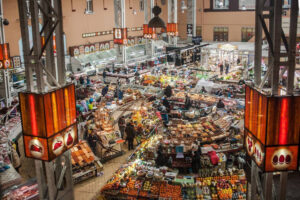
Ukrainian President Volodymyr Zelensky said that he is asking the US and Europe to ensure security for the elections, after which Ukraine will be ready to hold them in the next 60-90 days.
“Not only that, I am now asking, and I am stating this openly, for the US to help me, possibly together with European colleagues, to ensure security for the elections. Then, in the next 60-90 days, Ukraine will be ready to hold elections. I personally have the will and readiness to do so,” Zelensky told reporters on Tuesday.
At the same time, the president noted that the issue of elections in Ukraine depends primarily on Ukrainians, not on the people of other countries.
He stressed that he is ready for the elections, but explained that security and a legislative basis for their legitimacy are necessary for the elections to be held.
“Further, since this is how things have turned out, I ask that the deputies of our faction, in principle, our parliamentarians, prepare legislative proposals on the possibility of changing the legislative framework and the law on elections during martial law,” Zelensky added.
According to him, he is waiting for proposals from partners and deputies and is ready to go to the polls.

The price of silver on the spot market went up 3% during trading on Tuesday, hitting $60.24 per ounce, which is a new all-time high.
Gold rose 0.4% to $4,235.9 per ounce.
The rise in the cost of precious metals is driven by expectations that the Federal Reserve will cut its benchmark interest rate by 25 basis points following its next meeting on Wednesday. Based on futures quotes for the rate, traders estimate the probability of this at 89.6%, according to CME FedWatch.
If the forecast comes true, the rate will be reduced for the third consecutive meeting.
“Another 25 basis point rate cut is expected, which is generally optimistic for gold. The market remains strong and could reach record prices after the Fed’s announcement,” said Bob Haberkorn, senior market strategist at RJO Futures.
Currently, it takes 71 ounces of silver to buy 1 ounce of gold, compared to 82 ounces in October.
“The silver-to-gold price ratio is 70 times closer to the average for the last couple of decades, but historically we have gone as low as 40. So, there is definitely potential for growth,“ said Maria Smirnova, director of investments at Sprott Asset Management. ”If we don’t eliminate the deficit, silver has only one way to go — up.”

Representatives of the initiative group of regional federations announced a systemic crisis in the Ukrainian Boxing Federation and called for transparency and compliance with statutory norms ahead of the FBU conference scheduled for December 12.
The head of the FBU Control and Audit Commission, Konstantin Kalashnikov, announced that an initiative group had been formed from legally registered and actively operating regional branches, with about 15 organizations joining.
“The Ukrainian Boxing Federation is in a systemic crisis, so we have formed an initiative group of actively operating regional organizations. Our task is to restore the right to vote to the real federations and prevent decisions from being made behind closed doors or replaced by ‘paper’ branches; We will defend this right at the conference on December 12,” said Konstantin Kalashnikov, chairman of the FBU’s control and audit commission, at a press conference at the Interfax-Ukraine agency on Tuesday.
Kalashnikov also stated that the initiative group sees signs of a “raider takeover” and a violation of the principles of sports democracy in the actions of the current leadership. He separately drew attention to the risks to the international reputation of Ukrainian boxing due to cooperation with the IBA contrary to the position of the International Olympic Committee, and also announced the group’s intention to defend the position of the regions at the FBU conference.
In turn, FBU Vice President Andriy Kotelnyk noted that part of the boxing community does not support the split within the federation, but considers it unacceptable to ignore the IOC’s recommendations to distance itself from the IBA.
“The Ukrainian Boxing Association was created by an initiative group of five federations not to split or divide Ukrainian boxing, but to keep it in the Olympic Games. We supported the course of joining World Boxing, as recommended by the IOC, and want Ukrainian boxing to develop as a public, not a privatized structure,” said FBU Andriy Kotelnyk.
Kotelnyk also said that the initiative group had prepared a draft of the updated charter, which, according to them, preserves the role of regional centers, as well as a program for the development of Olympic boxing for the 2026–2028 and 2029–2032 cycles. He added that a number of companies have expressed their willingness to support the FBU, contributing approximately 25 million per year to the needs of Olympic boxing.
FBU presidential candidate and president of the Sumy Regional Boxing Federation Mykola Kravchenko presented his vision for reforms and a development program. Among his priorities, he named the institutional unification of the federation, fair and transparent elections of governing bodies, mechanisms for independent control, as well as financial motivation for athletes, coaches, and judges. He also supported the development of the National Boxing League and the project of a club championship based on the model of clubs symbolically associated with the structures of the Armed Forces of Ukraine.
“Ukrainian boxing has always been based on character, discipline, and tradition, but today it is time to move forward more boldly and in a more orderly manner. I propose institutional unification of the federation and transparent management without division into ‘us’ and ‘them’, fair and transparent elections of governing bodies, mechanisms for independent control and clear financial motivation for athletes, coaches and judges,” Mykola Kravchenko emphasized.
The president of the Kyiv City Boxing Federation, Oleksandr Negoda, gave examples of the work of the capital’s center and critically assessed the interaction with the leadership of the FBU. In particular, he reported that in 2025, three new halls were opened in Kyiv, one of which is in the Kyiv Sports Lyceum, and the closed city championship among youth and juniors attracted 428 participants, compared to the previous record of 170. At the same time, according to him, the Kyiv Federation’s request to include the Kyiv Cup tournament in the FBU calendar remained unanswered.
“We hold high-level capital championships and pay cash prizes to motivate our boxers, but the FBU completely ignores our appeals, in particular regarding the Kyiv Cup tournament. At the same time, at the last Ukrainian Cup, the prize was a certificate for 400 hryvnia—the Ukrainian Cup champion receives 400 hryvnia. How do you like that motivation?” asked the president of the Kyiv City Boxing Federation.
Negoda also drew attention to what he called “manipulation” with regional representation and referred to data from relevant agencies on the number of active regional federations within the FBU. He stated that some of the branches, which, according to him, are not active in all-Ukrainian competitions, retain the right to vote, while a number of federations with results at the national and international levels, in the opinion of the official, are deprived of this right.

Approximately $3.5 million has been invested in the modernization of the Bessarabsky Market in the capital and the launch of the “Bessarabka. Food Market” project, according to project manager Natalia Dzhuylay.
“The estimated investment in the modernization is about UAH 150 million (approximately $3.5 million at the exchange rate at the time of calculation). More than half of this amount was raised in the form of a loan, the rest — from the project participants’ own funds,” she told the media outlet “Reve ta stogne restaurator” (The Restorer Roars and Moans).
She noted that this project is changing the essence and purpose of the Bessarabsky Market: traders who have worked here for decades are returning to their places and continuing to work in the renovated, but essentially unchanged, shopping arcades.
According to her, the main principle of the food hall concept is that there should be no duplication of formats and menus, and each corner should occupy a unique niche. Contracts with residents are concluded for one year.
“In case of failure to meet the specified financial indicators, we reserve the right to replace the corner. But it is obvious that failure to meet KPIs is primarily unprofitable for the resident itself, as it means a lack of sufficient revenue and traffic. We are interested in each corner working effectively, so in case of a decline, we will analyze the reasons and look for ways to improve,” Dzhuay said.
The project’s Instagram page does not have an opening date, only an announcement that it will happen soon.
“Launching a project requires extensive preparation, coordination, and investment. We had to gather residents, set up retail spaces, and get ready. Some of the work had to be postponed. Ideally, the opening should have taken place in September, but it is more important for us to do everything well, rather than in a hurry. We are not afraid of the winter period — on the contrary, we want traders and restaurateurs to be able to work right now,” she said.
As previously reported by Village, as part of the gastronomic project “Bessarabka. Food Market,” 17 food corners and a separate bar are planned to open at the Bessarabsky Market, with a total of about 400 seats in various formats. Participation in the project “Bessarabka. Food Market” project include Ministry of Desserts, Himalaya, Buffalino, Burger Farm, Glek, Matsoni, Big Mama, Zharovnya, Tatarka, Sushi Icons, Gyros, Gelarty, Vytch, as well as the Cherry Coffee café and bar.
The Bessarabsky Market is one of the oldest covered markets in Ukraine, built at the beginning of the 20th century according to a design by architect Henrik Gay. Its building is a monument of architecture and urban planning of national importance.
Prior to this, in the summer of 2024, renovation work began on the Bessarabsky Market. The Kyiv City State Administration noted at the time that the post-Soviet superstructures were being removed from part of the premises, and the work did not involve any interference with the historical details of the structures. Since May 2025, the market’s refrigeration equipment has been upgraded to reduce energy consumption.

Since the end of November, State Enterprise “Forests of Ukraine” has sold over 17,000 Christmas trees worth UAH 3.5 million and has begun raids to detect illegal logging, with fines tripled ahead of the New Year holidays, the state enterprise’s press service reported on Telegram.
According to the report, the largest number of Christmas trees were sold in the branches of the Central Forest Office (6,900), the Northern Forest Office (3,700), and the Polissya Forest Office (3,400).
The average price of one Christmas tree sold is UAH 202 including VAT. In total, the state-owned enterprise plans to sell about 140,000 coniferous trees based on the experience of the previous Christmas and New Year season.
“Forests of Ukraine” reminded that branches of the state-owned enterprise organize retail trade at more than 300 trading sites: in forestry enterprises, fairs, and markets in populated areas. Information about the places of sale and contacts of responsible persons is posted on the website of the state-owned enterprise “Forests of Ukraine.”
In addition, Christmas trees can be pre-ordered by calling the nearest forestry office that sells them. After that, you can come, pay (payment can be made through a terminal in the forestry office/forestry department, at a bank branch, or through online banking), and pick up your New Year’s tree.
Prices for New Year’s conifers have remained almost unchanged compared to last year, averaging between 210 and 250 UAH. Spruce/fir trees cost between 240 and 280 UAH. The cheapest Christmas trees are offered by foresters in the wooded areas of the North and Polissya. For example, in Volyn, a 1.5-meter pine tree costs 180 UAH, and in Sumy and Chernihiv regions, 170 UAH. Prices are slightly higher in low-resource regions in the east and south and near large cities.
Some branches of the State Enterprise “Forests of Ukraine” offer Christmas trees in containers. Prices start at 500 UAH, depending on size.
At the same time, to protect coniferous plantations during the Christmas and New Year period, branches of the State Enterprise “Forests of Ukraine” have formed 295 mobile raid groups, comprising almost 1,000 people.
The raid groups conducted 385 joint raids, during which they detected 34 cases of illegal felling of coniferous trees and drew up 28 administrative reports totaling more than UAH 14,000.
The amount of the fine depends on the location of the illegally cut Christmas tree and its diameter at the root collar for trees up to 41 years old: up to 10 cm – 893 UAH (in nature reserves – 7,600 UAH); 10.1-14 cm – 1,500 UAH (13,300 UAH); 14.1-18 cm – over 4,000 UAH (34,700 UAH).
“In December and January, fines are three times higher! In case of significant damage (from 30,200 UAH) from the felling and sale of illegally felled trees, criminal punishment is provided!” – warned the state-owned enterprise.